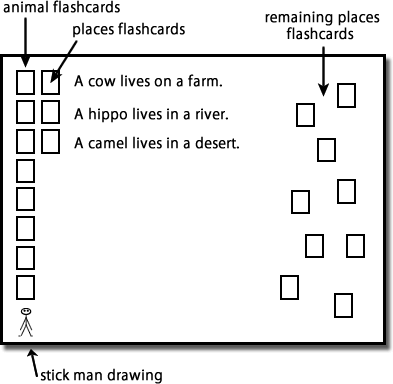Download a new song from ESL KidStuff: Where Do You Live?
 Where Do You Live?
Where Do You Live?
Song Theme: Talking about where animals and people live.
Target Vocab: Where do you live?, I live (in/on)…, fish, cow, bear, camel, bat, duck, goat, hippo, sea, farm, forest, desert, cave, lake, mountain, river, city, town, village, countryside.
Song Length: 2:23
A fun, lively song which practices asking where animals and people live. It also highlights different geological and living areas.
(Members can log in to download the full song)
Lyrics:
Chorus:
Where do you live?
Where do you live?
Where, oh where, oh
Where do you live?
Verse 1:
I am a fish, I live in the sea.
I am a cow, I live on a farm.
I am a bear, I live in a forest.
I am a camel, I live in a desert.
Chorus
Verse 2:
I am a bat, and I live in a cave.
I am a duck, I live on a lake.
I am a goat, I live on a mountain.
I am a hippo and I live in a river.
Chorus
Verse 3:
I live, I live, I live in a city.
I live, I live, I live in a town.
I live, I live, I live in a village.
I live, I live, I live in the countryside.
Gestures and activities to use with the “Where Do You Live?” song
During the song, student can either dance and do gestures, or complete a listening task worksheet:
- For gestures: students dance to the song and act as the animals in the song.
- For the listening worksheet: give a copy of the Where do you Live? Song Worksheet to everyone. Chorus the vocab and explain that everyone has to listen to the song to complete the sentences. Play the song 2-3 times until everyone has completed the worksheets. If your students enjoy the song, play once more with everyone dancing and doing animal gestures.
Using the “Where Do You Live?” song in class
This is a really lively, catchy song. It practices the structures of “Where do you live?” and “I live …”, introduces animals and places vocabulary and shows how to use the prepositions “in” and “on” for places.
- Review animal vocabulary – play “What animal am I?”: The song covers two different vocabulary areas: animals and places. At this stage your students should have covered some animal vocab so this can be a review of many of those animals. Before class print out the animal flashcards for fish, cow, bear, camel, bat, duck, goat, hippo. Also add any other animals your students have studied in previous lessons.
Start by modeling: look at a flashcard but don’t show anyone. Then act out that animal (also doing sounds), for example, walking on all fours saying “moooo!” (for cow). Students can put their hands up if they know the answer. Select a student – if he/she answers correctly he/she can do the next animal – show a flashcard and have them do the action. Again, the student who answers correctly can do the next animal. Continue until all the animals have been guessed.
Finally, stick the flashcards on the board. Put everyone in pairs to take turns in acting out and guessing the animals.
- Teach the vocabulary for places. Remove any animal flashcards from the board that are not in the song and then arrange the remaining animal flashcards in a column from the left-top of the board to the left-bottom (see image below). Make sure the animals are NOT in the order of the song if you are going to do the listening worksheet (as they will be listening for the correct order).
Next take the places flashcards and stick them randomly onto the right-side of the board. You are creating a matching activity on the board – students will need to match the places to where the animals live.
Start with the first animal (e.g. a cow) and say “Hmm. Where does a cow live?”. Gesture to the places pictures on the right. Point to the “sea” flashcard and say, “Does a cow live in the sea?”. Make it obvious that this is a crazy idea. Try pointing to a few more places flashcards until everyone has told you the correct card (a farm). Hold the farm flashcard up and chorus it 3 times. Place the farm flashcard next to the cow flashcard and write next to them, “A cow lives on a farm” and chorus 3 times.
Then, select a student to come to the board and stick the correct place flashcard next to the 2nd animal. If correct, praise the student and ask him/her to sit back down. Chorus the place 3 times, write the sentence on the board and chorus that 3 times. Continue until all the animals have places flashcards next to them.
Board layout:

You should still have 4 places flashcards remaining on the right-side of the board: city, town, village, countryside.
Under the last animal flashcard draw a stick man. Say, “I” and point to yourself. Point to each of the remaining places flashcards and chorus them. Stick all 4 next to the stick man and write 4 sentences (I live in a city, I live in a town, I live in a village, I live in the countryside). Chorus all four sentences. Then, say where you live (e.g. pointing at the town flashcard say “I live in a town”). Then go around the class, asking student where they live and having them all use the correct structure. Help out with the meanings of these words (e.g. a city is very, very big, a village is small, etc. – you can use place names familiar to your students, such as “Tokyo is a city”).
Now that you have all of the vocab and structures on the board, let’s practice. Put all students in pairs. Student A says an animal (or the word “I”) randomly, and their partner has to say the sentence (reading from the board). For example:
Student A: “A goat.“
Student B: “A goat lives on a mountain.“Get students to swap roles after each sentence. After a few minutes, explain that the students are going to test each other. Pairs sit facing each other – one student with his/her back to the board. The other student says an animal and listens to their partner saying the full sentence (he/she should help and correct if necessary). Make sure all students have a go at being tested.
- Play the “Flashcards Race” game. You will need 2 sets of the animals and places flashcards. Have everyone stand up and divide the class up into two teams – get each team to line up on either side of the classroom. Take the 2 sets of flashcards and shuffle each set. Scatter one set on the floor, face down, on the right-side of the classroom and do the same with the other set on the left-side of the classroom.
Now for the game: the first “player” from each team will have to race to find the correct cards and stick them on the board, according to your instructions. For example, shout “The bat lives in a cave”. The players from each team will run to their flashcards on the floor and turn them over until they find the “bat” and “cave” flashcards, then run to the board and stick them next to the sentence “A bat lives in a cave” (from point 2 above). Make sure that they leave all the flashcards on the floor turned face down.
Then continue with other students. Each time, the first student to place the correct flashcards next to the correct sentence on the board wins a point for his/her team.
Alternative #1: for fun, do silly sentences, such as “The hippo lives in a forest”.
Alternative #2: instead of putting the cards next to the sentence on the board, erase the sentences before starting the game. Each student then has to find the correct cards, put them on the board, and write the sentences correctly.
- Sing the “Where Do You Live?” song. You can either have everyone sing and dance along to the song or use our song worksheet as a listening task. Please see the “Gestures and activities to use with the “Where Do You Live?” song” above for full instructions.
- Create an “Animal Habitats” wall poster. We’ll end with a fun craft activity in which everyone creates a classroom poster. You will need a large sheet of construction paper / card for the poster sheet (as big as possible). Give everyone paper, colored pens, scissors and any other craft supplies you may have (e.g. glitter, cotton wool, etc.). Give everyone a task – to draw, color and cut out an animal or place (use the ones from the song) to put on the poster. Depending on the number of students you have you may need to give more than one picture for each student to do. Just make sure that all 8 animals and places are being made.
After everyone has drawn and cut our their pictures, get them to work together to glue the pictures onto the poster. For example, the student who created the bear and the student who created the forest will have to make sure they stick their pictures together so the bear is on the forest picture.
Finally, have the students draw speech bubbles next the pictures they have made and write inside the speech bubbles where animals live (e.g. “I am a fish. I live in the sea”).
Put the poster on the wall and give lots of praise as you go talk about their pictures. In future lessons, you can use this wall poster as a review exercise.
- Set Homework: For homework, give out the “Where do you live? Write” worksheet.
Related Stuff:
- Download all songs
- The Hello Song and The Goodbye Song
- The Numbers Song
- The ABC Song
- Head, Shoulders, Knees & Toes
- The Rainbow Song
- Old MacDonald
- What Can You Do?
- The Feelings Song
- The Days of the Week Song
- Months March song
- How Did You Get Here Today?
- Mr. Shape Head
- Let’s Go to the Zoo
- What Fruit do you Like?
- Where are my Things?
- The Morning Routines Song
- If You’re Happy and You Know It
- What Time is it?
- What’s Wrong? What’s the Matter?
- Numbers 1-20 song
- The Family Song
- Where are you Going? song


